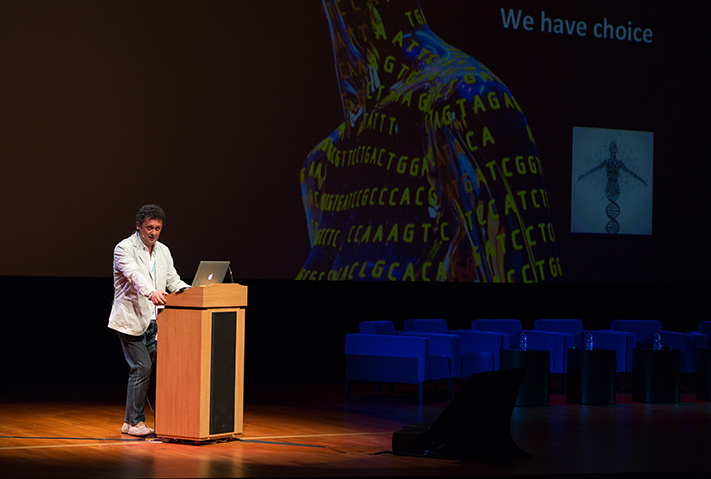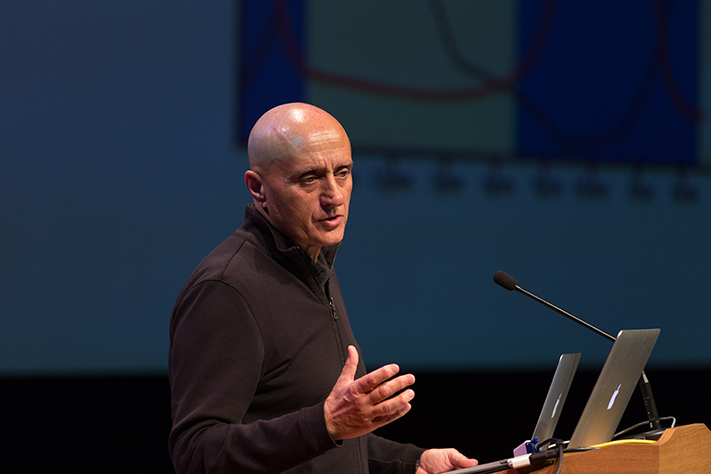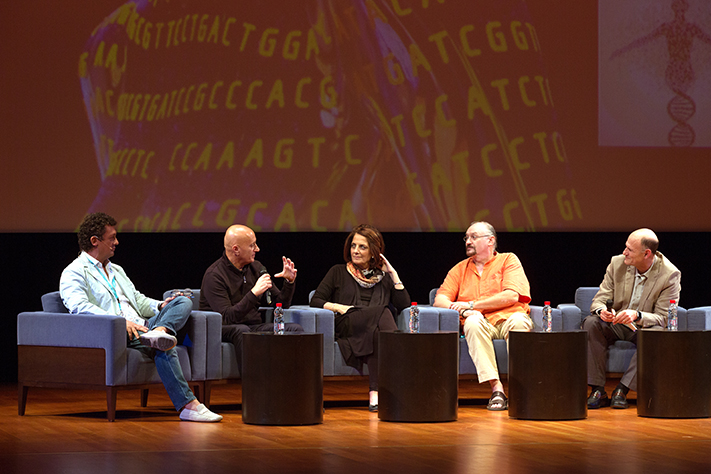At the forefront of epigenetics research

KAUST Professor of Bioscience Valerio Orlando, head of KEEP, speaks during the University's First International 2017 KAUST Research Conference on Environmental Epigenetics. Photo by Lilit Hovhannisyan.
The University hosted the first international 2017 KAUST Research Conference on Environmental Epigenetics from February 12 to February 15. The conference marked a strategic collaborative research program between the KAUST Environmental Epigenetics Program (KEEP), the Center for Epigenetics and Metabolism (CEM) at the University of California, Irvine, and the Gene Expression Laboratory at the Salk Institute for Biological Studies in California, U.S. The event covered the multifaceted, mechanistic roles that the epigenome and phenotypic variation play in development, cell and tissue identity, adaptation, tissue regeneration and inheritance.
In his opening address, KAUST Professor of Bioscience Valerio Orlando, head of KEEP, discussed the aims and vision of KEEP.
"Every cell or organism’s identity and performance is the result of a dynamic process comprising a continuous dialogue between the genome and the environment ending with the building of what we call 'cell memory.' This memory contains several layers or programs enabling adaptation to naturally changing environmental condition," Orlando explained.
"Epigenetics research investigates how a given cell or organism can fix and regulate the switch on or off for those different programs, revealing the multifaceted nature of genetic information and biodiversity. We can now measure the molecular and chemical parameters behind these processes, making it possible to unravel the molecular basis of genome function in diverse organisms as well as in human health and disease," he continued.
"We would also like the interdisciplinary and multisystems flavor of the conference to be an original cultural proposal in the field that we hope will make this event unique, and we hope that it will take place again in the future," he added. “The study of biodiversity also reflects the spirit of our University, a place where we promote a culture beyond science, but which highlights how science contributes to bringing us together."
New epigenetic information
Conference speaker Professor Azim Surani from the University of Cambridge focused his keynote lecture on the human germline, the specification of primordial germ cells (PGCs) in humans and mammals and the consequences this may have on human evolution and diseases.
“The reprogramming stage of the human germline cycle is quite important,” he noted. “We want to get closer to what we think is happening in the human cell process, and we must take the cells and find conditions that trigger the expression of a particular marker. The first thing we wanted to do is find out what the gene sequence was at the individual cell level. Only two percent of the genome is coding and the rest is a lot of repetitive elements. The genome is not a static set of instructions passed on from one generation to the next.”
“Imprinted genes regulate mammalian growth, behavior and physiology—these imprints are transmitted inter-generationally, and reset in every human germline,” he added.
From one cell to another
EPFL Lausanne Professor Johannes Graff’s keynote lecture entitled “Histone acetylation - molecular memory aids on the chromatin” concentrated on the role histone deacetylation plays in neurodegeneration and post-traumatic stress disorder and the chemical compounds that inhibit histone deacetylase. He noted how this epigenetic modification might become a new template for therapeutic interventions against cognitive frailty.
“For me, the field of epigenetics and neurobiology started with an essay by Sir Francis Crick. In the simplest terms, memory is the transferral of signals from one cell to another—our brains aren't built to hold memory for too long. Alzheimer's disease is the most prevalent neurodegenerative disease in the world today, and through our research we have found that the cognitive blockade related to Alzheimer's is potentially reversible,” he said.
The role nature and the environment play in gene modification
It is understood that the environment of relatives who came before us can have a significant impact on the legacy of our genes. The diet of a mother during pregnancy can affect her baby’s epigenetic profile, for example, and the diet of your parents, grandparents and great-grandparents can have a direct effect on you. In turn, you will pass this genetic information onto future generations.
KAUST Professor of Bioengineering Timothy Ravasi discussed the legacy of gene inheritance in his keynote address entitled “Rapid transgenerational adaptation of a reef fish to climate change.”
“Environment can shape the (epi)genome; a component interacts with the environment and this can shape the phenotype. Chemicals and pollutants induce epigenetic alterations and diet and food can shape the epigenome. The poor diet of the parents can increase the chance of their children inheriting obesity, for example,” Ravasi said.
Ueli Grossniklaus from ETH Zurich discussed how climate change poses a direct threat to biodiversity and agriculture, as well as acknowledging the large unknown degree plants can adapt to changing environment.
“We are slowly coming to an understanding of what happens in plants. In mammals, there are very few clear cut examples of transgenerational epigenetic inheritance; however, in plants this is quite different. Epigenetic variation exists and can be very stable and contribute to ecological variation. In plants, epialleles can be inherited over several generations,” he noted.
‘A great place for science’

Professor Paolo Sassone-Corsi from the University of California, Irvine, speaks during his address as part of the KAUST epigenetics research conference. Photo by Lilit Hovhannisyan.
Professor Paolo Sassone-Corsi from the University of California, Irvine, discussed epigenetics, nutrition and the circadian clock in his keynote address. He noted the circadian clock controls an array of physiological and metabolic functions and how it is vital to understand the interaction of circadian rhythms and metabolic processes on a cell- and tissue-specific level. He expanded on the evidence for the role of the circadian clock in linking enzymatic control and cellular metabolism and how this research has far-reaching implications for human physiology and disease.
“We have a clock in our head, but we also have clocks all over our body, and these are directly linked to your metabolism, with thousands of genes linked to these clocks. The sleep cycle is controlled by the circadian cycle and disruption of the clock may lead to various pathological conditions. Disrupting the circadian cycle can lead to weight gain and will influence our metabolism. If you eat three pizzas per day, you still have a circadian cycle, but it is different than if you're eating healthily,” Sassone-Corsi said.
During his talk on gene regulation and histone modifications in the yeast metabolic cycle (YMC), Professor Alberto Merchante Gonzalez from the University of Oxford spoke about histone modifications (HMs). According to Merchante Gonzalez, if HMs are prevented by amino acid substitutions, the YMC cycle stops, suggesting that HMs could be the regulators of transcript cycling.
“Histones can be modified at lysine residues by covalent acetylation and methylation—acetylation and methylation have different distributions along genes. The amplitude of oscillations is much larger for RNA and acetylation than for methylation. There is strong evidence for histones controlling the metabolic cycle. At Oxford, we are interested in developing a system control for our research,” he explained.
Scientific representations of the mission

From L to R: Professors Valerio Orlando, Paolo Sassone-Corsi, Emiliana Borrelli, Ueli Grossniklaus and Juan Carlos Belmonte take part in the conference’s roundtable discussion. Photo by Lilit Hovhannisyan.
Sassone-Corsi pointed out how impressed he was with the growth of KAUST and the role it plays—and can continue to play—in science and technology globally.
“KAUST is just a great place for science, and I hope meetings like this continue,” he said.
In his closing remarks, Orlando noted, “Our meeting is the expression of the philosophy of our epigenetics program—a program that is a mission to investigate phenotype variations. You are the scientific representations of this mission in the wider world.”
The conference was organized by the Biological and Environmental Science and Engineering (BESE) Division with financial support from the KAUST Office of Sponsored Research. Additional support was provided by the KAUST Industry Collaboration Program (KICP), Industry Partnerships Office.
- By David Murphy, KAUST News

